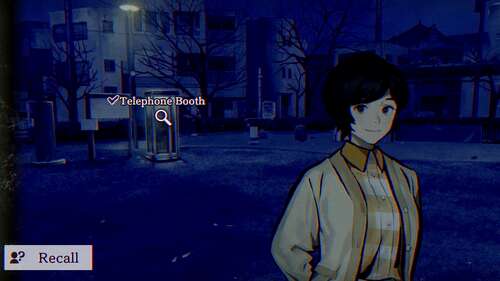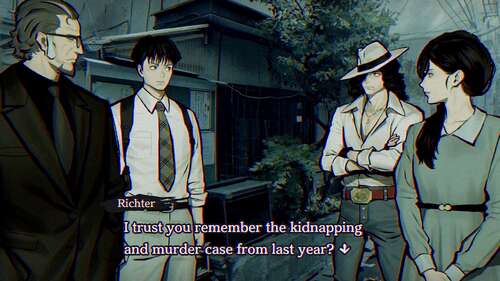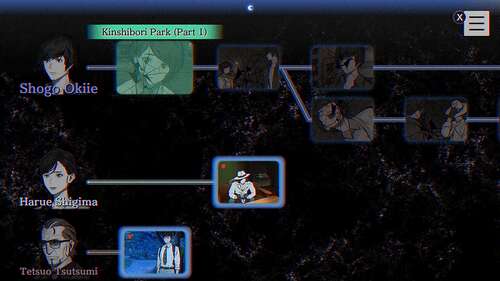Square Enix has gotten a lot of recent — and warranted — attention for the likes of Final Fantasy XVI and Octopath Traveler II, but one of the publisher’s other 2023 titles has sadly been overlooked: Paranormasight: The Seven Mysteries of Honjo.
Following an unveiling during the Japanese version of February’s Nintendo Direct, Square Enix released the murder mystery visual novel game just a few weeks later. All told, it was a pretty brief and quiet marketing cycle, and the only reason I even knew about it was because of a few mutuals on social media. Of course, it doesn’t help that this has been an unusually stacked year for such notable releases as Zelda, Mario, Spider-Man, Street Fighter, Diablo and Dungeons & Dragons.
But after hearing strong word of mouth from those who have played Paranormasight, I wanted to dive in myself, and I sure am glad that I did. Upon rolling credits, I found myself blown away by what developer xeen had accomplished with the horror-adventure title, a mesmerizing and utterly unique gem deserving of so much more recognition.
Having said that, I’ll admit that it’s a bit tricky to talk in further detail about Paranormasight. Really, it’s a game that’s best appreciated when you don’t know too much about it. All I really knew going in outside of a basic synopsis was that it hails from writer-director Takanari Ishiyama, a prolific game maker whose credits include everything from Metal Gear Solid and Final Fantasy to cult favourites like Schoolgirl Strikers and the Detective Ryosuke Kibukawa series. But for the sake of this editorial, I’ll try to break Paranormasight down in a pretty general (and absolutely spoiler-free) way.
 Set in Tokyo’s Sumida Ward in the late 20th century, Paranormasight follows an eclectic cast of characters as they grapple with a string of mysterious deaths seemingly tied to supernatural urban legends. At the root of these incidents are curses said to be able to bring back the dead. It’s a solid premise made all the more effective by the choice to use 360-degree cameras to capture real Tokyo settings, grounding the fantastical story in something tangible and, therefore, making it spookier.
Set in Tokyo’s Sumida Ward in the late 20th century, Paranormasight follows an eclectic cast of characters as they grapple with a string of mysterious deaths seemingly tied to supernatural urban legends. At the root of these incidents are curses said to be able to bring back the dead. It’s a solid premise made all the more effective by the choice to use 360-degree cameras to capture real Tokyo settings, grounding the fantastical story in something tangible and, therefore, making it spookier.
But it’s the ways in which Ishiyama mines this central story for surprisingly poignant character studies that really stand out. With the promise of resurrection, people from all walks of life find themselves succumbing to temptation. A young woman who misses her dead dog (which hit close to home.) A mother who mourns for her murdered son. A teenager longing for her recently deceased best friend. Paranormasight explores the lengths to which everyday people may go to undo a tragedy, and it gives everyone — even the seemingly most heinous — believable and sympathetic motivations. All the while, Paranormasight explores the effects that these obsessive quests can have on those around them, like a flamboyant private detective or a grizzled cop with a troubled past.
 Enhancing the already engrossing narrative is the aforementioned 360-degree camera setup, which you’re encouraged to fully rotate to unpack secrets in each area. Ishiyama’s clever blocking of each of these scenes means that you might even find surprises when you look away and look back, including a small — but nonetheless effective — number of jumpscares. Gorgeous and expressive character artwork, an eerie CRT TV aesthetic and Hidenori Iwasaki’s stellar genre-blending soundtrack only further add to the sublime presentation.
Enhancing the already engrossing narrative is the aforementioned 360-degree camera setup, which you’re encouraged to fully rotate to unpack secrets in each area. Ishiyama’s clever blocking of each of these scenes means that you might even find surprises when you look away and look back, including a small — but nonetheless effective — number of jumpscares. Gorgeous and expressive character artwork, an eerie CRT TV aesthetic and Hidenori Iwasaki’s stellar genre-blending soundtrack only further add to the sublime presentation.
Paranormasight also uses the multiple story paths framework better than most games I’ve seen. In general, each route runs concurrently, but progress in one might be halted until you get further along in another. This can be something as self-evident as one character’s major discovery leading them to cross paths with another to something as seemingly innocuous as light banter between cops about a household item proving vital in another storyline. The intricacies of how each campaign intersects — sometimes in astoundingly meta ways — are consistently surprising and deepened my already significant investment.
 In general, I appreciated how Paranormasight focuses on these little nuances — often engaging puzzles unto themselves — instead of a wide variety of different endings. To be sure, there are several possible outcomes, but they’re clearly meant to be the “bad” conclusions for each character, with one far more satisfying “true” ending — that brings everything together in a mind-blowing way that only games can accomplish — that can be unlocked under the right circumstances. It’s the richness and interconnectivity of Paranormasight‘s moment-to-moment storytelling that matters, not a million supposedly branching paths that ultimately amount to little as we’ve seen in many other choice-based narratives.
In general, I appreciated how Paranormasight focuses on these little nuances — often engaging puzzles unto themselves — instead of a wide variety of different endings. To be sure, there are several possible outcomes, but they’re clearly meant to be the “bad” conclusions for each character, with one far more satisfying “true” ending — that brings everything together in a mind-blowing way that only games can accomplish — that can be unlocked under the right circumstances. It’s the richness and interconnectivity of Paranormasight‘s moment-to-moment storytelling that matters, not a million supposedly branching paths that ultimately amount to little as we’ve seen in many other choice-based narratives.
In this way, Paranormasight also makes itself far leaner — and, therefore, easier to recommend — than some other visual novels. Overall, it took me about 12 hours to achieve the optimal ending, which is the perfect length for this story. In a year with 100-hour games like Tears of the Kingdom and Baldur’s Gate 3, I only appreciate that tightness all the more.
Already, I feel like perhaps I’ve said too much about Paranormasight, but I so adored what I played that I’m just desperate to get more people to share the experience. As a long proponent of storytelling in games, Ishiyama’s latest work does everything I want from a narrative in the medium, mixing a gripping plot and compelling characters with mechanics that only a game could provide. Whether you play it this month in time for Halloween or later down the line, Paranormasight is absolutely one of 2023’s best games.
Paranormasight: The Seven Mysteries of Honjo is available on Nintendo Switch (reviewed), PC (Steam), Android and iOS.
Image credit: Square Enix

